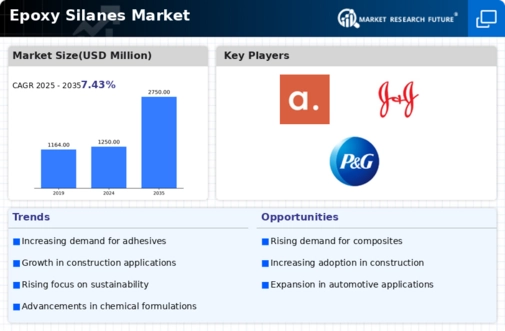Market Analysis
In-depth Analysis of Epoxy Silanes Market Industry Landscape
Epoxy Silanes are a crucial chemical industry segment, and their production, demand, and market trends are shown by their market dynamics. Since they improve adhesion and crosslinking, epoxy silanes are used in adhesives, sealants, and coatings. Technological advances drive formulation, manufacturing, and application developments in the Epoxy Silanes market. To stay ahead of technical changes, manufacturers invest in R&D and supply high-quality epoxy silanes for various sectors.
Global demand and supply affect the Epoxy Silanes market. Domestic and international economic conditions drive demand for these chemicals across sectors. Economic downturns limit industrial activity, lowering epoxy silane consumption, whereas economic prosperity boosts utilization in various applications. Market health affects investment, production, and pricing, as does the global economy.
The Epoxy Silanes market is being influenced by environmental factors. Sustainability and eco-friendliness are driving demand for chemicals with little environmental impact. Pressure is on manufacturers to use greener production methods, develop epoxy silanes with better environmental characteristics, and investigate ecologically friendly uses. In an environmentally sensitive market, epoxy silane companies that prioritize sustainability may have an advantage.
Due to their importance in material performance, Epoxy Silanes market rivalry is fierce. Manufacturers must differentiate through quality, cost-effectiveness, and innovation. Differentiation strategies like creating epoxy silane formulations for specific applications or improving performance are vital to market share. Companies must continuously research and develop to stay ahead of the competition and suit client needs.
Trade policies and geopolitics affect Epoxy Silanes market dynamics. Trade restrictions, import/export rules, and geopolitical conflicts can affect epoxy silane availability and pricing worldwide. Manufacturers must monitor trade policies and geopolitics to alter their strategy and reduce global market risks.
Epoxy Silanes market regulations and standards also matter. Compliance with safety, quality, and environmental standards is essential for market acceptance. Proactively addressing regulatory issues helps epoxy silane companies retain marketability and good relations with customers and regulators.
Consumer choices and market developments affect Epoxy Silanes market dynamics. Consumer preferences for high-performance materials, sustainable formulations, and cost-effectiveness can influence epoxy silane selection. These developments require manufacturers to adapt their products to changing consumer expectations and market trends.






Leave a Comment